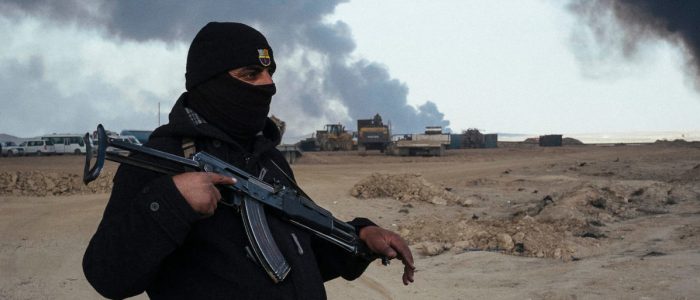
Islamic State terrorists continuing with attacks in Iraq and Syria during the coronavirus crisis
Attacks by ISIS and other armed groups are continuing in Iraq and Syria as some US-led coalition forces withdraw and the novel coronavirus sweeps the region.
In Iraq, attacks continue in areas disputed between the autonomous Kurdistan Region and federal Iraqi governments. The mixed Turkmen-Kurdish city of Tuz Khurmatu, south of Kirkuk, experienced mortar and explosive attacks three times during the week of March 16, according to one official from the quasi-governmental Iraqi High Commission for Human Rights.
“We are scared of the disputed territories returning to the previous situation of conflict,” Dr. Ali Al Bayati told The Media Line. “This is making civilians again a target for terrorists.”
Tuz Khurmatu is near the Hamrin Mountains, which have been a base for armed groups in Iraq since before ISIS. Iraqi Defense Ministry spokesman Brig. Gen. Yehia Rasool announced on March 22 that the Iraqi Air Force bombed ISIS hideouts in the mountains, purportedly killing dozens of ISIS fighters.
In Syria, attacks by ISIS and unidentified groups are similarly continuing. In March 2019, the Kurdish-led Syrian Democratic Forces (SDF) announced the defeat of ISIS in Syria after the Battle of Baghouz Fawqani, near the Iraqi border. In Iraq, the government in Baghdad declared victory over the Sunni Islamist group at the end of 2017.
This February in SDF territory in northeast Syria, though, ISIS and other groups carried out 53 attacks, mostly targeted killings and home invasions in the Deir ez-Zur and Raqqa areas, according to a report from the Rojava Information Center. The Qamishli-based organization, which uses the Kurdish name for northeast Syria, compiled a map of recent ISIS attacks in northeast Syria, partly based on open-source information.
ISIS has shifted tactics from attacks in major population centers in the area, which local authorities call the Autonomous Administration of North and East Syria.
“ISIS and other sleeper-cells seem to have changed their tactics, focusing less on indiscriminate car-bombs in city centers, and instead specifically targeted individuals connected to the Autonomous Administration or the Syrian Democratic Forces,” Rojava Information Center researcher Robin Fleming said in the report. “This may indicate decreased capacity, but is an effective way of using fear to drive Arab communities away from the SDF.”
There are also non-ISIS groups that claim attacks on the SDF, including Ahrar al-Shab, another Sunni Salafi-jihadist group.
Amid ISIS’s continuing attacks, the US-led international coalition against ISIS in Iraq and Syria has started to remove some of its forces from Iraq.
On March 20, the coalition, officially known as Combined Joint Task Force-Operation Inherent Resolve (CJTF-OIR), said it would return some forces involved in training to their home countries. It cited success in the fight against ISIS and the spread of the novel coronavirus.
“The Coalition is adjusting its positioning in Iraq for two reasons: long-planned adjustments to the force to reflect success in the campaign against Daesh; and, short-term moves to protect the force during the Coronavirus pandemic,” read a statement, using the Arabic acronym for ISIS.
American and allied military positions in Iraq have also been attacked several times since the US’s killing of Iranian Maj. Gen. Qasem Soleimani in Baghdad in January. Most recently, rockets hit the Iraqi military base Camp Taji, where coalition troops are stationed, on March 14. The coalition and Iraqi forces did not immediately say who was behind the attack.
The pro-Iran Hashd al-Shaabi (aka the Popular Mobilization Units) militias have denied carrying out some of the recent attacks on American targets. Hashd al-Shaabi is an Iraqi state-sponsored umbrella organization composed of some 40 militias that are mostly Shi’ite groups.
The coronavirus has affected the SDF’s anti-ISIS operations in Syria as well. On March 24, the group called for a truce among all parties in the Syrian civil war to allow for a better defense against the virus’s spread.
ISIS could return to Iraq and Syria in many ways. In Syria, the SDF was hampered by Turkey’s attack on its territory in October.
Some observers also say the SDF’s governance will not take root in the most violent parts of its territory. The SDF controls many areas that are largely Arab, such as Deir ez-Zur and Raqqa. The SDF is dominated by the Kurdish group the People’s Protection Units (YPG), which shares an ideology with the leftist Kurdish group from Turkey the Kurdistan Workers’ Party (PKK) − though the YPG denies formal connections. Many Arabs reject rule by the Kurdish group, a rejection that benefits ISIS, according to one researcher on Syria.
“There was never any hope that the Arab tribes in the Jazira would get used to a PKK regime,” Kyle Orton told The Media Line, referring to the northeast Syrian province. “In that legitimacy gap, ISIS has found space to move.”
Orton said the coalition erred in thinking that there was a purely military solution to ISIS.
“The underlying problem with Operation Inherent Resolve was that it tried to tackle ISIS as a military problem in isolation from the political situation,” he said. “The military campaign itself took longer than it should have done and caused far more destruction, human and material, than necessary.”
In Iraq, Bayati said it is possible the recent Tuz Khurmatu attacks occurred because of the sense that the federal government is not strong in the face of ongoing anti-government protests and the coronavirus’s spread.
“There is weakness in Baghdad now because of the political situation and the new disaster of the corona,” he said.
Syria and Iraq must face ISIS in this context of a partially withdrawn international coalition and an increasing number of coronavirus cases.
Source: The Media Line





